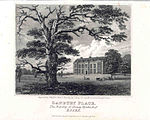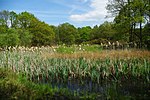Blake's Wood & Lingwood Common

Blake's Wood & Lingwood Common is a 93.2-hectare (230-acre) biological Site of Special Scientific Interest in Danbury in Essex. It is owned by the National Trust and the local planning authority is Chelmsford City Council.The soils on this site are glacial sands and gravels over London clay, resulting in a mixture of woodland, heath and bog habitats. Blake's Wood is ancient woodland on a sloping site, with valleys and streams. The main trees are oak, together with other species such as hornbeam and sweet chestnut. There is a wide variety of birds, such as hawfinches and nightingales, and the underlayer is dominated by bluebells and primroses. The heath is being invaded by trees and bracken. Acid grassland is dominated by red fescue, and there are two rare moths, Deltote bankiana and Elaphria venustula.There is access from Riffhams Chase, which separates the two parts of the site, with the wood to the north and the common to the south.
Excerpt from the Wikipedia article Blake's Wood & Lingwood Common (License: CC BY-SA 3.0, Authors, Images).Blake's Wood & Lingwood Common
The Rye Field, Chelmsford Little Baddow
Geographical coordinates (GPS) Address Nearby Places Show on map
Geographical coordinates (GPS)
| Latitude | Longitude |
|---|---|
| N 51.731438 ° | E 0.565309 ° |
Address
Blakes Wood
The Rye Field
CM3 4TR Chelmsford, Little Baddow
England, United Kingdom
Open on Google Maps









